If you want to improve your website’s search engine rankings, finding the right keywords is essential. One of the best tools to help with this is the Semrush Keyword Magic Tool. In this guide, we’ll show you how to use the Semrush keyword magic tool and how it can help you grow your website’s traffic in 2024.
What Is the Semrush Keyword Magic Tool?
The Semrush Keyword Magic Tool is a powerful tool that helps you find the best keywords for your website or blog. It shows you a list of related keywords based on the main keyword you enter. This helps you discover new keywords, find out how difficult it is to rank for them, and even learn how many people are searching for them.
In 2024, the Semrush keyword magic tool remains one of the best tools for keyword research. It is easy to use, and it provides a lot of useful information. Whether you are a beginner or an experienced SEO expert, the Semrush keyword magic tool can help you.
Why Should You Use the Semrush Keyword Magic Tool?
- Find High-Quality Keywords
The Semrush keyword magic tool gives you access to a large database of keywords. This means you can find keywords that are highly relevant to your niche. It also shows you related keywords that you may not have thought about. - Understand Keyword Difficulty
The tool also provides information on the difficulty level of ranking for a keyword. This helps you choose keywords that are easier to rank for, especially if your website is new or has low authority. - See Search Volume
The Semrush keyword magic tool shows you how many people are searching for a particular keyword. This is important because targeting high-volume keywords can help bring more traffic to your website. - Discover Long-Tail Keywords
Long-tail keywords are longer, more specific phrases that are easier to rank for. The Semrush keyword magic tool makes it easy to find these keywords, which can help you target a more specific audience.
How to Use the Semrush Keyword Magic Tool
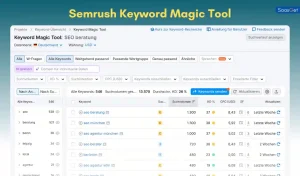
Now that we know what the Semrush keyword magic tool is and why it is useful, let’s look at how you can use it. The tool is simple, and you don’t need to be an SEO expert to use it effectively.
Step 1: Log in to Semrush
First, you need to log in to your Semrush account. If you don’t have an account, you can create one by visiting Semrush’s website and signing up for a free trial or paid plan. Once you are logged in, you will see the dashboard.
Step 2: Go to the Keyword Magic Tool
After logging in, find the Keyword Magic Tool in the left-hand menu under the “Keyword Research” section. Click on it to open the tool.
Step 3: Enter a Seed Keyword
In the Semrush keyword magic tool, you will be asked to enter a “seed keyword.” This is the main keyword you want to research. For example, if your website is about digital marketing, your seed keyword could be “digital marketing.” Once you enter the keyword, click the “Search” button.
Step 4: Review the Keyword Results
The Semrush keyword magic tool will display a list of related keywords. You will see the following information for each keyword:
- Search Volume: This shows how many people are searching for the keyword each month.
- Keyword Difficulty: This shows how hard it is to rank for that keyword. The higher the number, the harder it is to rank.
- CPC (Cost Per Click): This shows how much advertisers are paying for that keyword if they are using Google Ads.
- Competition: This shows how competitive the keyword is in the paid search market.
Step 5: Filter and Sort Keywords
To make your research easier, you can use filters to narrow down the list of keywords. You can filter by:
- Search Volume: Choose keywords with a high or low search volume, depending on your needs.
- Keyword Difficulty: Select keywords that are easier to rank for.
- CPC: If you are looking to target high-value keywords, you can filter by CPC.
- Match Type: You can choose between broad, phrase, or exact match types.
Using these filters helps you focus on the best keywords for your website.
Step 6: Save and Export Your Keywords
Once you have found the keywords you want to target, you can save them in your Semrush account. You can also export them to a CSV file if you want to work with them outside of Semrush. This is helpful if you are doing keyword research for multiple pages or articles.
Best Practices for Using the Semrush Keyword Magic Tool
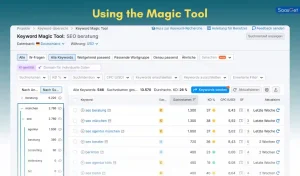
To get the most out of the Semrush keyword magic tool, here are some best practices to follow:
- Start with a Broad Seed Keyword
When using the Semrush keyword magic tool, begin with a broad seed keyword. This allows the tool to generate a wide variety of related keywords. For example, if you are in the health niche, start with a general keyword like “health” and refine the results from there. - Use Long-Tail Keywords
Long-tail keywords are usually less competitive and more specific. These keywords are often easier to rank for. The Semrush keyword magic tool is great for discovering long-tail keywords that can bring targeted traffic to your website. - Focus on Search Intent
When you choose keywords, think about the search intent behind them. Are people looking for information? Are they ready to buy something? Make sure the keywords you target match the intent of your audience. - Track Keyword Performance
After selecting your keywords, track how they perform over time. Use the Semrush tools to monitor your rankings and adjust your strategy as needed. - Use Keywords in Your Content
Once you have chosen your keywords, use them in your content. Make sure the keywords appear in important places like the title, headings, and throughout the body of your text. But remember, don’t overdo it—use keywords naturally.
Advanced Features of the Semrush Keyword Magic Tool
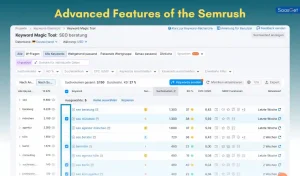
The Semrush Keyword Magic Tool offers several advanced features that can help you refine your keyword research even further. These features are designed to make your SEO strategy more effective and help you stay ahead of your competition. Let’s explore some of these advanced options.
1. Keyword Grouping
One of the best features of the Semrush Keyword Magic Tool is keyword grouping. After you search for a seed keyword, the tool automatically groups related keywords into categories. These categories are based on themes or topics, which makes it easier for you to organize your keywords.
For example, if your seed keyword is “content marketing,” the Semrush keyword magic tool might group keywords related to “SEO content,” “blog writing,” “content strategy,” and so on. This allows you to target specific areas within a broader topic and create more focused, relevant content.
2. Keyword Suggestions Based on SERP Analysis
The Semrush keyword magic tool can also help you discover keywords based on SERP (Search Engine Results Page) analysis. This means that the tool looks at the search engine results for a particular keyword and provides suggestions based on what pages are ranking. This is particularly useful for discovering keywords that your competitors are targeting.
For example, if you enter “SEO tools” as your seed keyword, the tool will show you related keywords that are being used on pages that rank high for SEO-related searches. By focusing on these keywords, you can make sure your content is competitive in the search results.
3. Filters for Local Keyword Research
If your website targets a local audience, the Semrush keyword magic tool can help you with local keyword research. The tool allows you to filter results based on location, so you can see the search volume for a specific region or country. This is important if you are targeting a particular market, as local search behavior can differ from global trends.
For example, if you are running a business in Bangladesh and want to focus on local SEO, you can filter the results to only show keywords with high search volume in Bangladesh. This can help you optimize your content for local search and reach a more relevant audience.
4. Keyword Trends and Seasonality
Another great feature of the Semrush keyword magic tool is the ability to track keyword trends and seasonality. The tool shows you how the search volume for specific keywords changes over time. This can be extremely helpful if you want to target keywords that are seasonal or have fluctuations in search volume.
For example, if you run an e-commerce store that sells holiday decorations, you can use the Semrush keyword magic tool to identify keywords that peak around the holidays. By planning your content or advertising campaigns around these trends, you can increase traffic and sales.
5. SERP Features and Keyword Opportunities
The Semrush keyword magic tool also provides insights into SERP features, such as Featured Snippets, Local Packs, and Knowledge Panels. This is important because these features often appear at the top of search results and can drive significant traffic to your website.
By analyzing which keywords trigger these SERP features, you can focus on creating content that is more likely to appear in them. For example, if a certain keyword shows up in a Featured Snippet, you can optimize your content to answer that specific question in a way that increases your chances of ranking in the snippet.
Semrush Keyword Magic Tool vs. Other Keyword Research Tools
There are many keyword research tools available today, but the Semrush keyword magic tool stands out because of its comprehensive features and ease of use. Let’s compare it to some other popular keyword research tools.
1. Google Keyword Planner
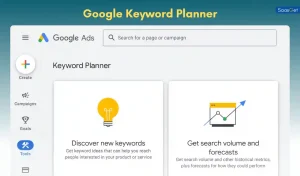
Google Keyword Planner is one of the most popular tools for keyword research. However, it has some limitations when compared to the Semrush keyword magic tool. For one, it only provides limited data unless you run paid ads. In contrast, Semrush gives you more detailed information, including keyword difficulty, CPC, and competition levels.
Additionally, Google Keyword Planner doesn’t offer keyword grouping or the ability to analyze competitors’ keywords as easily as Semrush does.
2. Ahrefs Keyword Explorer
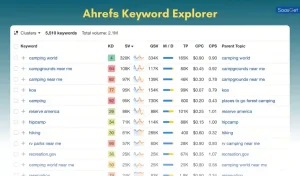
Ahrefs Keyword Explorer is another strong competitor to the Semrush keyword magic tool. Ahrefs provides similar features, including keyword difficulty and search volume. However, the Semrush keyword magic tool stands out with its keyword grouping and filtering options, which make it easier to organize and refine your keyword research.
Semrush also offers more precise data on keyword trends and seasonality, which is a great advantage for businesses that want to target seasonal keywords.
3. Moz Keyword Explorer
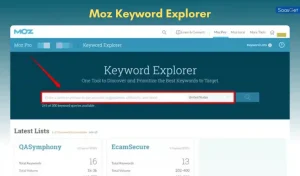
Moz Keyword Explorer is a popular tool among SEO professionals. It provides keyword suggestions, search volume, and keyword difficulty. However, compared to the Semrush keyword magic tool, Moz lacks advanced features like keyword grouping and detailed SERP analysis. While Moz is a good option for basic keyword research, Semrush offers more in-depth features that can give you an edge in your SEO strategy.
4. Ubersuggest

Ubersuggest is a free tool created by Neil Patel that provides keyword suggestions, search volume, and competition data. While Ubersuggest is a good option for beginners or those on a budget, the Semrush keyword magic tool offers more accurate and comprehensive data, including keyword difficulty, trends, and SERP features.
How to Optimize Your Website Using Keywords from the Semrush Keyword Magic Tool
Now that you’ve found your keywords using the Semrush keyword magic tool, the next step is to use them effectively on your website. Here’s how to optimize your content:
1. Use Keywords in Your Content
Incorporate your target keywords naturally into your content. Place them in key locations such as:
- Title tag: The title of your page or post is one of the most important SEO factors.
- Headings: Use your keywords in subheadings (H1, H2, H3) to organize your content and make it easy for readers to understand.
- Meta description: This is the short description that appears under your page title in search results. Including your keyword here can improve click-through rates.
- Body text: Use your keywords throughout the content, but avoid keyword stuffing. Focus on providing valuable and informative content that your readers will find useful.
2. Optimize for User Intent
Make sure your content matches the search intent behind the keywords. For example, if someone is searching for “best SEO tools,” they are likely looking for a list of tools to try. Create content that answers their question or solves their problem.
3. Create High-Quality Content
Content quality is a key ranking factor. After selecting your keywords, make sure you create high-quality content that provides value to your audience. Google rewards well-written, informative, and engaging content with higher rankings.
Tracking Your Keyword Performance
![]()
After using the Semrush Keyword Magic Tool to find your keywords and optimize your website, it’s essential to track how well those keywords are performing. Regular monitoring helps you make adjustments and stay competitive. Here’s how to do it effectively:
1. Use Semrush’s Position Tracking Tool
Semrush offers a position tracking tool that helps you monitor the rankings of the keywords you are targeting. Once you have selected your keywords in the Semrush keyword magic tool, you can set up a project in Semrush and track how your website ranks for each keyword over time. This tool allows you to:
- Track organic keyword rankings: See how your website is performing in organic search results for each targeted keyword.
- Monitor competitors: Compare your rankings with your competitors to see where you stand.
- Track SERP features: Check if your content is appearing in rich snippets, local packs, or other SERP features.
- Track mobile and desktop rankings: You can see how your keywords rank on mobile and desktop devices separately, which is crucial since user behavior may differ on these platforms.
Tracking your keywords regularly ensures you can spot any drops in rankings and take quick action to improve your SEO strategy.
2. Use Google Search Console for Keyword Insights
Google Search Console is another tool that can help you track how your keywords are performing. It provides information about:
- Impressions: The number of times your website appeared in search results for a given keyword.
- Clicks: The number of times users clicked on your link after searching for a keyword.
- Average position: The average ranking position of your website for a specific keyword.
By integrating Google Search Console with your Semrush keyword magic tool research, you can get a clearer picture of how your keywords are performing and make improvements as needed.
3. Analyze Keyword Traffic with Google Analytics
Once your content is ranking for your target keywords, use Google Analytics to monitor the traffic coming from those keywords. This tool shows you the number of visitors landing on your website from search engines. You can analyze:
- Organic traffic: See how many visitors come to your website from organic search.
- Keyword performance: While Google Analytics doesn’t show exact keyword data, you can link it to Google Search Console to track keyword performance.
- Bounce rates: Check if users are leaving your site quickly. High bounce rates can indicate that your content doesn’t meet their expectations, which may require adjustments.
By analyzing the traffic and user behavior, you can refine your SEO strategy and target more effective keywords.
Common Mistakes to Avoid with the Semrush Keyword Magic Tool
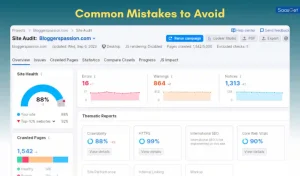
While the Semrush keyword magic tool is incredibly useful, there are some common mistakes that people often make. Let’s go over them and how to avoid them.
1. Focusing Only on High-Volume Keywords
While high-volume keywords may seem attractive because they get searched a lot, they can also be very competitive. If your website is new or lacks authority, it might be difficult to rank for these keywords.
Solution: Use a mix of high-volume, medium-volume, and long-tail keywords. The Semrush keyword magic tool helps you identify long-tail keywords with lower competition and more specific search intent. These are often easier to rank for and can bring in more qualified traffic.
2. Overstuffing Keywords in Your Content
Keyword stuffing is the practice of placing a keyword excessively in your content. While it might seem like this will help you rank better, it can actually harm your SEO efforts. Search engines like Google prioritize user experience, and content that is stuffed with keywords feels unnatural and difficult to read.
Solution: Use your target keywords naturally in your content. Focus on creating valuable, high-quality content that satisfies the user’s search intent. Keep the keyword density moderate and focus on writing for the reader, not just for search engines.
3. Ignoring Search Intent
One common mistake when using the Semrush keyword magic tool is choosing keywords based solely on search volume, without considering search intent. Different keywords have different intentions behind them. Some users are looking for information, while others are ready to make a purchase.
Solution: Always consider the search intent behind a keyword. If you’re targeting informational keywords, create content that answers questions. If you’re targeting transactional keywords, make sure your content or landing page is optimized for conversions.
4. Not Updating Your Keyword List Regularly
Keyword trends can change over time. New keywords may become popular, and old ones may lose their relevance. If you don’t update your keyword list regularly, you might miss out on opportunities to attract new traffic.
Solution: Regularly revisit the Semrush keyword magic tool to find new keyword opportunities and monitor the performance of existing ones. Keep an eye on industry trends and adjust your keyword strategy accordingly.
Conclusion: Unlock Your SEO Potential with the Semrush Keyword Magic Tool
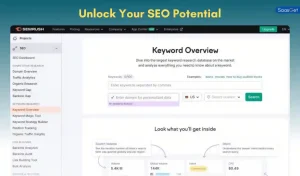
The Semrush keyword magic tool is an invaluable resource for any SEO strategy. Whether you’re a beginner or an experienced professional, it can help you discover the best keywords for your website, understand their search volume and competition, and track your performance over time.
By following the tips in this guide, you can use the Semrush keyword magic tool to find high-quality keywords, optimize your content, and ultimately drive more organic traffic to your website. With continuous monitoring and optimization, you’ll be able to stay ahead of the competition and improve your search engine rankings in 2024.
So, start using the Semrush keyword magic tool today and unlock your website’s full SEO potential!


